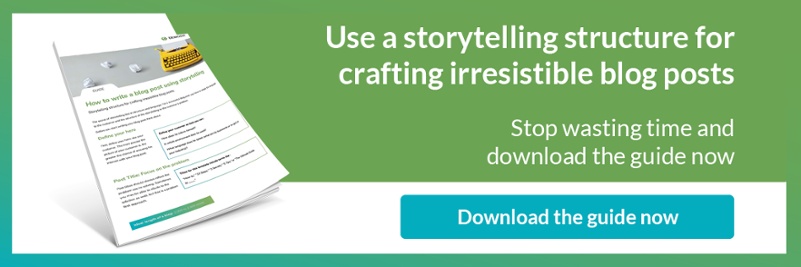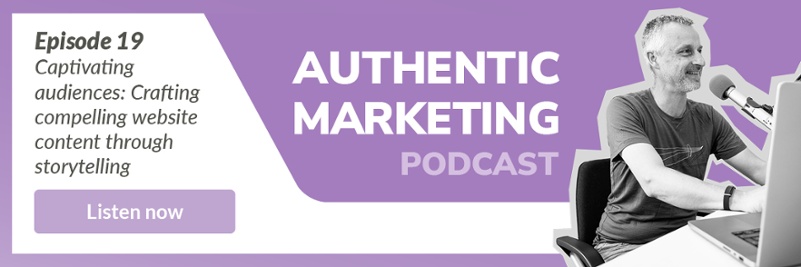Storytelling in blog posts - A simple guide to use

Blog posts can ignite the turbo for your content marketing, but they can also be very time consuming. However, to experience the power of blog posts, it's not enough to fire up ChatGPT and have them spit out a new, boring version of old news.
Relevant blog posts can drive people to your website, promote your brand and generate leads. In order for your blog post to engage your readers and stick in their minds, you need to use storytelling (something ChatGPT is lousy at, by the way) because stories create emotions and emotions anchor information in our memory. We understand that storytelling is not for everyone, but we also know from experience that anyone can successfully become a storyteller with our structure. You may not become a Hemingway, but you will be able to write compelling blog posts that interest your readers.
Although storytelling is one of the buzzwords of the marketing scene, it is an old hat. Some researchers even argue that storytelling has been around since we humans developed language. The principles of storytelling are also well known. Aristotle already taught the basics of storytelling.
The secret of storytelling lies in structure and language. For a successful blog post, you have to adapt the language to the customer and the structure of the storytelling to the customer's problem. However, the principles remain the same.
The storytelling structure for marketing
There is:
- A hero, who in storytelling for marketing is always the customer
- who has a problem and
- you as the brand are the guide who shows the hero how to solve his problem,
- because you have a plan and
- tell the hero what he has to do (Call To Action).
- You show him what will happen if he refuses your help (Failure)
- and you guide him to the happy end (he buys your product and becomes your customer).
For a blog post, you can easily apply brand storytelling.
Define your hero
First, define your hero, aka your customer. Define your customer as best you can:
- How does he inform himself?
- In which environment does he work?
- What language does he speak (what are his buzzwords or no-go's in your industry)?
The more precise the picture of your customer is, the greater the chance of arousing his interest with your blog post.
The driving force of your storytelling: The problem
After the hero, a.k.a. the customer, you take care of the driving force of your storytelling: the problem.
Of course, your customers don't have just one problem, but in your blog post you should focus on one problem. If you try to solve more than one problem in a blog, you dilute your message and lose the effective storytelling structure (of course, your problem can have different aspects, but you should not solve two different problems in one go. Storytelling is not a washing machine into which you put a pile of clothes and then start spinning. To stay in the simile of laundry: storytelling works like a long clothesline where you hang up one garment after the other and keep a linear structure).
How to identify a problem?
- Urgency: At Demodia, we optimise websites. We use storytelling for this, but also digital know-how. As of 1 September, the revised data protection law comes into force for all Swiss companies. We developed best practice methods on how to adapt websites and email marketing to the new requirements and published a blog post about it, because the adaptations should be tackled as soon as possible, otherwise there may be severe penalties from 1 September. So it's urgent.
- Relevance: Find out from account managers what problems your customers are having and identify an issue that affects as many customers as possible.
- Save costs: If you offer a solution to a problem that saves your customers money, you're sure to get 100% attention, because our brains have specialised over millennia of evolution to retain information that moves us forward.
The basic structure of every story - as Aristotle already knew - consists of a beginning, middle and end.
The structure of your blog
Your problem should form the beginning of your blog. We recommend that you describe your client's problem, which you want to solve with your blog post, in the very first paragraph or, if possible, even in the first sentence.
In the middle of your blog post, you describe the plan you have as a mentor for your client's problem. You show empathy, because empathy is a feeling that creates a deep connection. Empathy strengthens client relationships. By empathising with our customers' situations and experiences, we can improve our customer relationships and make a positive impact.
You should also talk about your authority. At Demodia, we provide guidance on storytelling because we have the only two certified Storybrand Guides in Switzerland. Storybrand is a method by bestselling author Donald Miller that has been tried and tested thousands of times. Storybrand successfully applies the classic elements of storytelling to marketing.
For years, we have been combining storytelling with automation for our clients -,we are a certified HubSpot partner afterall. This allows us to precisely measure the successes that storytelling brings for our clients.
Convinced? That was the idea and an example of how to demonstrate authority in a blog post.
In addition to empathy and authority, what the mentor needs most is a plan, because you need to convince your client that your plan offers the best solution to their problem. In this blog post, for example, we show that anyone can succeed in storytelling for their brand with the right structure. To do this, we explain the structure and show how to implement this plan by describing the stages of storytelling.
If you do without storytelling, you risk being forgotten again quickly, because facts that are integrated into stories are remembered 16 times better by the customer. Those who still think that only the facts about the product are convincing are ignoring the fact that people make most decisions motivated by a mixture of emotions and facts. With storytelling you serve both levels.
In the previous section, we clarified the pitfall. What happens if you don't use storytelling? What will your world look like? The answer: you will be forgotten and less likely to be considered in a buying decision.
Now only two elements from the storytelling structure are missing. Tell your customer what their world looks like after they've used your product. Describe their happy ending. In our case, we can guarantee that with storytelling you will be better remembered, create more closeness to your customers and stand out from the competition.
Now there is one last element missing. The element that brings you sales and therefore must not be forgotten. Your blog post should definitely end with a call-to-action. Tell your customer exactly what next step you expect them to take.
By the way, we also missed a blog post on Call to Actions and all the other stages of the storytelling structure. Just have a look at our homepage. But if you already know that you need support with automated storytelling for your brand, we invite you to a virtual coffee here.
PS: Was the blog post interesting? It follows our storytelling structure exactly;)

